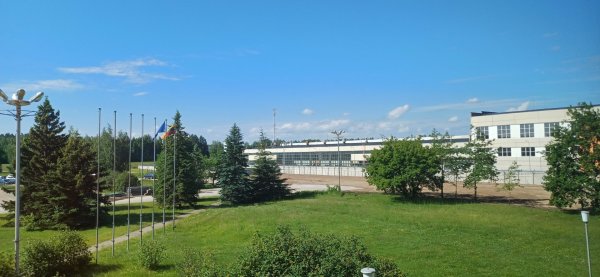More and more space for green field on the INPP site: an administrative building has been finally cleaned up
2024

Although more than 40% of the Ignalina Nuclear Power Plant's (INPP) equipment has been dismantled and the plant's normal appearance has not yet changed, the number of buildings on the site is also starting to decrease. One of the most important works on the INPP site this year was completed at the beginning of the summer, when one of the INPP's larger buildings was finally cleaned up and will be replaced by a lawn.
The multi-storey building, which until 2013 housed administrative staff and has a total area of almost 10 000 m2 and a volume of almost 60 000 m3, is treated as finally demolished following the signing of the Technical Acceptance Certificate for the demolition works.
Although the building, unused for more than a decade, met uncontrolled levels of contamination, i.e. it could have been demolished, the INPP faced challenges in isolating the building from the rest of the INPP facilities, which required the reconstruction of the gallery that provides access for staff to the more remote areas, and the relocation of the physical protection perimeter.
Although the building was part of the administrative use group, which is not subject to additional restrictions, the project was carried out in different phases: firstly, the demolition of the passageway gallery, which connected the passageway to the other passageway corridors for employees, and then the reconstruction of the adjacent industrial building, with the demolition of another passageway gallery, followed by the reconstruction of the perimeter of the protection area, and then, only after the completion of the construction of the fence and the paths of the protection area of the INPP had been granted, the building itself.
The concrete and masonry waste from the demolition was recycled into rubble, part of which (16 788.42 t) was used to backfill the foundation pits. The total volume of demolition waste generated amounts to more than 17,000 tonnes, including concrete, glass, ferrous metal and mixed waste.
Ignalina NPP structures that need to be demolished (often after dismantling of the engineering systems of the structure and removal of the radioactive contamination layer/structures), after management of all clean-up and demolition wastes, are classified as managed waste groups.
This vacated part of the main INPP site is an exemplary result of a successful demolition project, with the aim of returning as much of the site as possible to public use, as part of the INPP's exclusively long-term mission "Creating a clean environment through sustainable management of the legacy of nuclear activities".

